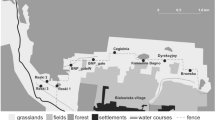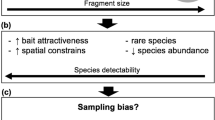Abstract
The Neotropical region hosts one of the highest levels of small non-volant mammal species diversity worldwide, but sampling therein is often intractable due to high logistic and labour costs. While most common sampling methods include live trapping (LT) and pitfall trapping (PT), camera trapping (CT) is potentially a useful technique. Studies assessing data acquisition efficiency for neotropical small mammals are mostly limited to LT and PT, and no small mammal study to date included CT. We provide a comparative assessment of the efficiency of LT (Sherman and wire-mesh traps), PT and CT in surveying small mammal species across 25 sites in an Amazonian archipelagic landscape. Based on 26,184 trap nights, we obtained 782 small mammal records representing at least 18 species. Most species were detected by both LT (72.2%) and PT (83.3%), but each of these methods exclusively recorded additional species, whereas CT detected only nearly one-fourth (N = 4) of all species recorded. Nevertheless, for nearly all species detected by CT, the probability of detecting individual species was similar or higher than that of LT. Species detected by CT represented the largest-bodied rodents and marsupials (> 200 g). Pitfall traps are an important complement to LT, and CT comprises an efficient technique to sample large-bodied small mammals. Improvements in the efficiency of camera traps in recording and identifying small-bodied species are both needed and possible, but we recommend the combination of LT and PT methods to enhance the completeness of community-wide small mammal sampling in neotropical forests.


Similar content being viewed by others
References
Adler GH, Lambert TD (1997) Ecological correlates of trap response of a neotropical forest rodent Proechimvs semispinosus. J Trop Ecol 13:59–68
Ahumada JA, Silva CEF, Gajapersad K, Hallam C, Hurtado J, Martin E, McWilliam A, Mugerwa B, O’Brien T, Rovero F, Sheil D, Spironello WR, Winarni N, Andelman SJ (2011) Community structure and diversity of tropical forest mammals: data from a global camera trap network. Philos Trans R Soc Lond Ser B Biol Sci 366:2703–2711
American Veterinary Medical Association (2013) AVMA guidelines for the euthanasia of animals. https://www.avma.org/KB/Policies/Documents/euthanasia.pdf. Accessed Jan 2014
Ardente NC, Ferreguetti AC, Gettinger D, Leal P, Martins-Hatano F, Bergallo HG (2017) Differential efficiency of two sampling methods in capturing non-volant small mammals in an area in eastern Amazonia. Acta Amazon 47:123–132
Benchimol M, Peres CA (2015) Widespread forest vertebrate extinctions induced by a mega hydroelectric dam in lowland Amazonia. PLoS One 10:e0129818
Boonstra R, Krebs CJ (1978) Pitfall trapping of Microtus townsendii. J Mammal 59:136–148
Bovendorp RS, McCleery RA, Galetti M (2017) Optimising sampling methods for small mammal communities in Neotropical rainforests. Mammal Rev 47:148–158
Buckner CH (1964) Preliminary trials of a camera recording device for the study of small mammals. Can Field Nat 78:77–79
Castleberry SB, Mengak MT, Menken TE (2014) Comparison of trapping and camera survey methods for determining presence of allegheny woodrats. Wildl Soc Bull 38:414–418
Comissão de Ética, BioÉtica e Bem-Estar Animal/CFMV (2012) Guia Brasileiro de Boas Práticas em Eutanásia em Animais - Conceitos e Procedimentos Recomendados. Brasília, Brazil. http://portal.cfmv.gov.br/uploads/files/Guia%20de%20Boas%20Práticas%20para%20EEutanasi.pdf. Accessed Jan 2014
De Bondi N, White JG, Stevens M, Cooke R (2010) Comparison of the effectiveness of camera trapping and live trapping for sampling terrestrial small-mammal communities. Wildl Res 37:456–465
Emmons L, Feer F (1997) Neotropical rainforest mammals: a field guide. University of Chicago Press, Chicago
FUNCATE/INPE/ANEEL (2000) Mapeamento por satélite das áreas inundadas por reservatórios de hidrelétricas brasileiras. Unpublished Report. Convênio FUNCATE/INPE/ANEEL, São Paulo
Gardner TA, Barlow J, Araujo IS, Ávila-Pires TCS, Bonaldo AB, Costa JE, Espósito MC, Ferreira LV, Hawes J, Hermandez MI, Hoogmoed M, Leite RN, Lo-Man-Hung NF, Malcolm JR, Martins MB, Mestre LAM, Miranda-Santos R, Nunes-Gutjahr A, Oveal WL, Parry LTW, Peters SL, Ribeiro-Júnior MA, Silva MNF, Silva-Motta C, Peres CA (2008) The cost-effectiveness of biodiversity surveys in tropical forests. Ecol Lett 11:139–150
Glen AS, Cockburn S, Nichols M, Ekanayake J, Warburton B (2013) Optimising camera traps for monitoring small mammals. PLoS One 8:e67940
Hannibal W, Caceres NC (2010) Use of vertical space by small mammals in gallery forest and woodland savannah in South-Western Brazil. Mammalia 74:247–255
Hice CL, Schmidly DJ (2002) The effectiveness of pitfall traps for sampling small mammals in the Amazon basin. Mastozool Neotrop 9:85–89
Hillebrand H, Matthiessen B (2009) Biodiversity in a complex world: consolidation and progress in functional biodiversity research. Ecol Lett 12:1405–1419
Hobbs MT, Brehme CS (2017) An improved camera trap for amphibians, reptiles, small mammals, and large invertebrates. PLoS One 12:e0185026
IBAMA (1997) Plano de manejo fase 1: Reserva Biológica do Uatumã. Eletronorte/Ibama. Brasília/DF. http://www.icmbio.gov.br/portal/images/stories/docs-planos-de-manejo/rebio_uatuma_pm.pdf. Accessed 10 Sept 2017
Jones KE, Bielby J, Cardillo M, Fritz SA, O'Dell J, Orme CDL, Safi K, Sechrest W, Boakes EH, Carbone C, Connolly C, Cutts MJ, Foster JK, Grenyer R, Habib M, Plaster CA, Price SA, Rigby EA, Rist J, Teacher A, Bininda-Emonds ORP, Gittleman JL, Mace GM, Purvis A (2009) PanTHERIA: a species-level database of life history, ecology, and geography of extant and recently extinct mammals. Ecology 90:2648–2648
Krebs CJ (1966) Demographic changes in fluctuating populations of Microtus californicus. Ecol Monogr 36:239–273
Larrucea ES, Brussard PF (2008) Efficiency of various methods used to detect presence of pygmy rabbits in summer. West N Am Nat 68:303–310
Larsen TH (2016) Core standardized methods for rapid biological field assessment. Conservation International, Arlington
Laurance WF (1992) Abundance estimates of small mammals in Australian tropical rainforest: a comparison of four trapping methods. Wildl Res 19:651–655
Macedo J, Loretto D, Vieira MV, Cerqueira R (2006) Classes de desenvolvimento em marsupiais: um método para animais vivos. Mastozool Neotrop 13:133–136
Malcolm JR (1991) The small mammals of Amazonian forest fragments: pattern and process. PhD thesis, University of Florida
Mangan SA, Adler GH (2000) Consumption of arbuscular mycorrhizal fungi by terrestrial and arboreal small mammals in a panamanian could forest. J Mammal 81:563–570
McClearn D, Kohler J, McGowan KJ, Cedeno E, Carbone LG, Miller D (1994) Arboreal and terrestrial mammal trapping on Gigante peninsula, Barro Colorado nature monument, Panama. Biotropica 26:208–213
McCleery RA, Zweig CL, Desa MA, Hunt R, Kitchens WM, Percival HF (2014) A novel method for camera-trapping small mammals. Wildl Soc Bull 38:887–891
Norris D, Michalski F, Peres CA (2010) Habitat patch size modulates terrestrial mammal activity patterns in Amazonian forest fragments. J Mammal 91:551–560
O’Connell AF, Nichols JD, Karanth KU (2010) Camera traps in animal ecology: methods and analyses. Springer, London
Oksanen J, Kindt R, Legendre P, O’Hara B, Stevens MHH (2007) Vegan: the community ecology package. R package version 2, pp 4–2
Oliveira-Santos LG, Tortato MA, Graipel ME (2008) Activity pattern of Atlantic Forest small arboreal mammals as revealed by camera traps. J Trop Ecol 24:563–567
Palmeirim AF, Benchimol M, Vieira MV, Peres CA (2018) Small mammal responses to Amazonian forest islands are modulated by their forest dependence. Oecologia 187:1–14. https://doi.org/10.1007/s00442-018-4114-6
Patton JL, Da Silva MNF, Malcolm JR (2000) Mammals of the Rio Juruá and the evolutionary and ecological diversification of Amazonia. Bull Am Mus Nat Hist 244:1–306
R Core Team (2015) A language and environment for statistical computing. R Foundation for Statistical Computing, Vienna
Ribeiro-Júnior MA, Rossi RV, Miranda CL, Ávila-Pires TC (2011) Influence of pitfall trap size and design on herpetofauna and small mammal studies in a Neotropical Forest. Zoologia (Curitiba) 28:80–91
Ripley B, Canty A (2017) Boot: bootstrap functions. R package version 1, pp 3–19
Santos-Filho M, Silva DJ, Sanaiotti TM (2006) Efficiency of four trap types in sampling small mammals in forest fragments. Mato Grosso, Brazil Mastozool Neotrop 13:217–225
Santos-Filho MD, Lázari PRD, Sousa CPFD, Canale GR (2015) Trap efficiency evaluation for small mammals in the southern Amazon. Acta Amaz 45:187–194
Sikes RS (2016) 2016 guidelines of the American Society of Mammalogists for the use of wild mammals in research and education. J Mammal 97:663–688
Silveira L, Jácomo ATA, Diniz-Filho JAF (2003) Camera trap, line transect census and track surveys: a comparative evaluation. Biol Conserv 114:351–355
Terborgh J, Lopez L, Nuñes PV, Rao M, Shahabuddin G, Orihuela G, Riveros M, Ascanio R, Adler GH, Lambert TD, Balbas L (2001) Ecological meltdown in predator-free forest fragments. Science 294:1923–1926
Tilman D (2000) Causes, consequences and ethics of biodiversity. Nature 405:208–211
Umetsu F, Naxara L, Pardini R (2006) Evaluating the efficiency of pitfall traps for sampling small mammals in the Neotropics. J Mammal 87:757–765
Vieira EM, Monteiro-Filho ELA (2003) Vertical stratification of small mammals in the Atlantic rain forest of South-Eastern Brazil. J Trop Ecol 19:501–507
Villette P, Krebs CJ, Jung TS (2017) Evaluating camera traps as an alternative to live trapping for estimating the density of snowshoe hares (Lepus americanus) and red squirrels (Tamiasciurus hudsonicus). Eur J Wildl Res 63(1):7
Voss RS, Lunde DP, Simmons NB (2001) The mammals of Paracou, French Guiana: a neotropical lowland rainforest fauna part 2. Nonvolant species. Bull Am Mus Nat Hist 263:3–236
Welbourne DJ, MacGregor C, Paull D, Lindenmayer DB (2015) The effectiveness and cost of camera traps for surveying small reptiles and critical weight range mammals: a comparison with labour-intensive complementary methods. Wildl Res 42:414–425
Wilman H, Belmaker J, Simpson J, de la Rosa C, Rivadeneira MM, Jetz W (2014) EltonTraits 1.0: species-level foraging attributes of the world's birds and mammals. Ecology 95:2027–2027
Woodman N, Timm RM, Slade NA, Doonan TJ (1996) Comparison of traps and baits for censusing small mammals in Neotropical lowlands. J Mammal 77:274–281
Zar JH (1999) Biostatistical analysis. Prentice Hall, Upper Saddle River
Acknowledgements
We are grateful to all 19 volunteers and field assistants who helped during field campaigns and to M. N. da Silva for helping with species identification.
Funding
Funding was provided by the Fundação de Amparo à Pesquisa do Estado do Rio de Janeiro–FAPERJ (grant Cientistas do Nosso Estado to MVV), Conselho Nacional de Desenvolvimento Científico e Tecnológico (CNPq; Grant to MVV), Natural Environment Research Council (NERC; grant NE/J01401X/1 to CAP) and the Post-Graduate Program in Ecology of the Federal University of Rio de Janeiro. The Uatumã Biological Reserve provided logistic support during fieldwork, and additional resources or equipment were provided by The Rufford Small Grants Foundation, RFP-Wildlife Conservation Society, The Conservation, Food and Health Foundation, and Idea Wild. AFP and MB were funded by the Coordenação de Aperfeiçoamento Pessoal de Nível Superior scholarship from the Brazilian Ministry of Education.
Author information
Authors and Affiliations
Corresponding author
Additional information
Communicated by: Magdalena Niedziałkowska
Publisher’s note
Springer Nature remains neutral with regard to jurisdictional claims in published maps and institutional affiliations.
Electronic supplementary material
ESM 1
(DOCX 167 kb)
Rights and permissions
About this article
Cite this article
Palmeirim, A.F., Benchimol, M., Peres, C.A. et al. Moving forward on the sampling efficiency of neotropical small mammals: insights from pitfall and camera trapping over traditional live trapping. Mamm Res 64, 445–454 (2019). https://doi.org/10.1007/s13364-019-00429-2
Received:
Accepted:
Published:
Issue Date:
DOI: https://doi.org/10.1007/s13364-019-00429-2




